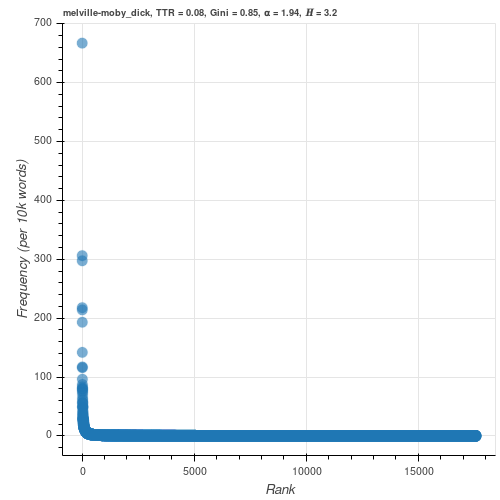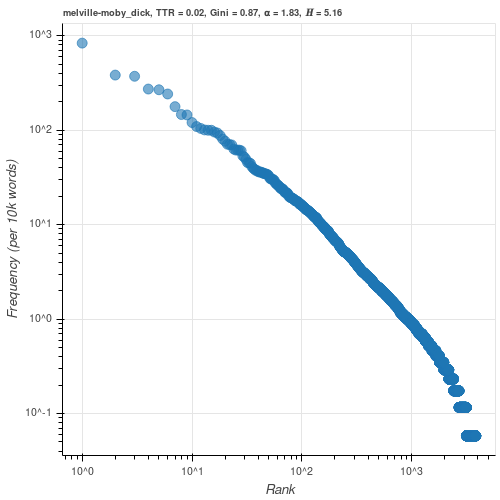English Philology, University of Oulu, Finland, steven.coats@oulu.fi
5th DHN Conference
National Library of Latvia, October 2020
Outline¶
Visualization of frequency distributions
ZipfExplorer tool
Discourse comparison
Lexical diversity
Visualization of frequency distributions¶
If the word types in a text are ranked in decreasing order of their frequencies, the frequency $n$ of a word with rank $r$ is approximately inversely proportional to its rank (Zipf, 1935, 1949)
$$ n \propto r^{-z} $$Where $z$ typically has a value close to $1$

Taking the logarithm of both sides
$$ \log{n} = -z \log r $$yields Zipf's familiar rank-frequency plot when plotted in log-log space with slope $\approx -z$

ZipfExplorer tool¶
https://zipfexplorer.herokuapp.com
- Visualization of rank-frequency profile of shared vocabulary types in two texts (or one text)
- Individual word types can be selected and highlighted
- Frequent types can be removed
- Users can upload texts (in .txt format)
- Several lexical diversity measures calculated
- Created with the Bokeh package for visualization in Python (Bokeh Development Team, 2020)
- Advantage over (e.g.) Shiny, Plotly or Dash: Simultaneous interaction in two data frames
- Data: Texts from Gutenberg project, Brown and FROWN corpora, US presidential inaugural addresses (Francis & Kučera, 1979; Hundt et al. 1999; Bird et al., 2019)
- Github: https://github.com/stcoats/zipf_explorer
Discourse comparison¶
- Word types are presented in tables below the plots
- Types sortable by word, relative frequency, relative frequency difference, or log-likelihood score (Dunning, 1993; Rayson & Garside, 2000)
- Keywords (Stubbs, 2010) can shed light on discourse differences
Lexical diversity¶
- Type-token ratio
- $\alpha$ parameter of power-law distribution
- Gini coefficient
- Shannon entropy
Type-token ratio¶
$$ \frac{number~of~distinct~types}{number~of~tokens} $$- Ranges from $\lim_{x \to 0^+}$ (no diversity) to $1$ (maximum diversity)
$\alpha$ parameter of power-law distribution¶
Zipf's rank-frequency function is equivalent to the complementary cumulative distribution function of the Pareto distribution (Newman, 2005)
If the frequency $n$ of a word with rank $r$ is $r^{-z}$, its derivative is a continuous approximation of the probability of encountering a type with frequency $n$
The new exponent $\alpha$ is related to the exponent of Zipf's Law:
$$ \alpha = 1+\frac{1}{z} $$- if $z=1$, $\alpha=2$
- $\alpha$ is better-behaved as a random variable than is $z$ and is a better fit for actual texts (Moreno-Sánchez et al., 2016)
- The ZipfExplorer calculates $\alpha$ using the PowerLaw package (Alstott et al., 2014; Clauset et al., 2009)
- Typically ranges between $\sim1.5$ and $3$
Gini Coefficient¶
- Used to characterize wealth/income equality
- For $n$ word types with relative frequency $x$:
- Ranges from $0$ (equality) to $1$ (maximum inequality)
Shannon entropy¶
- The average amount of information, in bits, we need to represent a message (Shannon, 1948)
- For $n$ word types with relative frequency $x$:
- High entropy: words not re-used
Low entropy: words re-used
Maximum entropy: $log_{2}n$
Summary¶
- Open-source tool for comparison of shared word frequencies
- Potential uses: Discourse analysis, distant reading, teaching (Zipf distributions, visualizations)
That's all! Thanks for listening!¶
References¶
Alstott, J., Bullmore, E. & Plenz, D. (2014). Powerlaw: a Python package for analysis of heavy-tailed distributions. PLoS ONE 9(1).
Bird, S., Loper, E. & Klein, E. (2019). Natural language processing with Python. Newton, MA: O'Reilly.
Bokeh Development Team. (2020). Bokeh: Python library for interactive visualization. http://www.bokeh.pydata.org, last accessed 01/03/2020.
Clauset, A., Shalizi, C. R. & Newman, M. E. J. (2009). Power-Law distributions in empirical data. SIAM Review 51(4), 661–703.
Dunning, T. (1993). Accurate methods for the statistics of surprise and coincidence. Computational Linguistics 19, 61–74.
Francis, W. N. & Kučera, H. (1979). A standard corpus of present-day edited American English, for use with digital computers. Providence, RI: Brown University.
Hundt, M., Sand, A. & Skandera, P. (1999). Manual of information to accompany The Freiburg – Brown Corpus of American English ('Frown'). Freiburg, Germany: Department of English, Albert-Ludwigs-Universität.
Moreno-Sánchez, Font-Clos, F. & Corral, Á. (2016). Large-scale analysis of Zipf's Law in English texts. PLoS ONE 11(1): e0147073. https://doi.org/10.1371/journal.pone.0147073
Newman, M. E. J. (2005). Power laws, Pareto distributions and Zipf's law. Contemporary Physics 46(5), 323–351.
Rayson, P. & Garside, R. (2000). Comparing corpora using frequency profiling. In: WCC '00 proceedings of the workshop on comparing corpora, pp. 1–6. New York: ACM.
Shannon, C. E. (1948). A mathematical theory of communication. Bell System Technical Journal 27, 379–423; 623–656.
Stubbs, M. (2010). Three concepts of keywords. In: Bondi, M., Scott, M. (eds.), Keyness in texts, pp. 21–42. Amsterdam: John Benjamins.
Zipf, George K. (1935). The psycho-biology of language. Cambrdige, MA: Riverside Press.
Zipf, G. K. (1949). Human behavior and the principle of least effort. Cambridge, MA: Addison-Wesley.